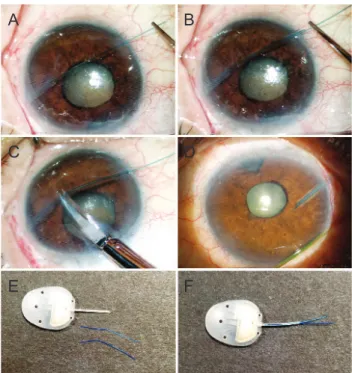© 2018 The Korean Ophthalmological Society
This is an Open Access article distributed under the terms of the Creative Commons Attribution Non-Commercial License (http://creativecommons.org/licenses /by-nc/3.0/) which permits unrestricted non-commercial use, distribution, and reproduction in any medium, provided the original work is properly cited.
523
Management of Postoperative Ocu- lar Hypotony after Tube Surgery by Stenting Using Two 5-0 Nylon Threads
Dear Editor,
Despite the introduction of valved devices and tube liga- tion, ocular hypotony remains an important complication after tube surgery. When postoperative ocular hypotony occurs due to overdrainage through the tube, tube occlu- sion by ligation or stenting may be required. To perform the ab externo approach, the conjunctival wound should be reopened, and this may increase the risk of bleeding, fibro- sis, or device exposure at the operation site. Thus, when conjunctival scarring is excessive or the conjunctiva is thin, the ab externo approach is limited. When tube length is sufficient to be extracted from the anterior chamber through the corneal incision, the anterior chamber-posi- tioned part of the tube can be ligated and repositioned into the anterior chamber. However, ligation of the tube at a fo- cal area may not induce sufficient and predictable outflow control [1]. Previous studies reported that intraluminal stenting produced effective and predictive outflow control [2-4]. Thus, ab interno tube stenting may be an effective method to manage postoperative ocular hypotony. We pres- ent a case of ocular hypotony after Ahmed glaucoma valve (AGV; New World Medical, Rancho Cucamonga, CA, USA) implantation that was resolved by stenting using two 5-0 nylon threads with an ab interno approach.
A 50-year-old man with neovascular glaucoma under- went AGV implantation to control intraocular pressure (IOP). Despite previous trabeculectomy and maximal med- ical treatment, his IOP was greater than 35 mmHg. In- tra-operatively, the superior-temporal conjunctiva was in- cised, and a body plate was placed approximately 12 mm posterior to the corneal limbus. The tube was ligated with 8-0 vicryl and entered into the anterior chamber. After AGV implantation, the IOP ranged from 7 to 10 mmHg without complications. However, two weeks after the sur- gery, IOP suddenly decreased to 2 mmHg, and the patient’s
vision decreased from 20 / 400 to hand motion. The anteri- or chamber was shallow, and hypotony maculopathy was identified. Given that the ocular hypotony occurred 2 weeks postoperatively, excessive aqueous drainage through the tube due to loosening of tube ligation was suspected. To elevate IOP by intraluminal stenting with an ab interno ap- proach, a corneal incision was made opposite the tube. A 5-0 nylon thread was inserted into the tube lumen using forceps (Fig. 1A). In the same manner, the second 5-0 nylon thread was inserted into the tube lumen (Fig. 1B). After making an- other corneal incision, the nylon threads were cut with scis- sors (Fig. 1C). To remove the thread, a small portion of it was left protruding from the tube tip (Fig. 1D). After this proce- dure, IOP was 8, 7, 14, and 29 mmHg at 1, 3, 5, and 10 days, respectively. Timolol/dorzolamide fixed-combination eye drops were applied twice daily, and IOP decreased to 10 mmHg. Both threads were removed 30 days after stenting by retraction. The IOP ranged from 10 to 13 mmHg without IOP-lowering medication for 6 months after this procedure, and vision recovered to 20 / 400.
Korean J Ophthalmol 2018;32(6):523-524 https://doi.org/10.3341/kjo.2018.0092
Fig. 1. Anterior segment photographs of (A-C) intraoperative and (D) postoperative intraluminal stenting of the tube using two 5-0 nylon threads. Two threads of 5-0 nylon were (A,B) stented and (C) cut with an ab interno approach. (E,F) To reduce the risk of stent displacement, bent threads can be used.
a
C
E
B
D
F
524
Korean J Ophthalmol Vol.32, No.6, 2018
Tubes can be stented using various suture threads. For instance, in a previous case, a single 4-0 polypropylene thread was used to manage ocular hypotony [5]. Given that the internal diameter of the tube is approximately 300 µm, and the 4-0 polyprolene thread diameter is approximately 150 µm, stenting with a single 4-0 thread may not induce sufficient IOP elevation in all cases. Thus, we used two 5-0 nylon threads with diameters of approximately 140 µm per thread. This method may improve IOP elevation compared to stenting with a single 4-0 thread. When performing tube stenting, cautionis needed so as to not destroy the valve in the body plate with an overly-long stent. After stenting, the intraluminal threads can be inferiorly displaced, and this may cause corneal endothelium irritation. Thus, close ob- servation is needed after this procedure. We suggest that use of a bent thread may reduce the risk of stent displace- ment (Fig. 1E, 1F). To date, this is the only report of ocular hypotony managed with two 5-0 nylon threads. We think that ab interno tube stenting using two 5-0 nylon threads may be an effective method to manage postoperative ocu- lar hypotony after AGV implantation.
Soo Hyun Lim, Young Hoon Hwang
Department of Ophthalmology, Kim’s Eye Hospital, Myung- Gok Eye Research Institute, Konyang University College of Medicine, Seoul, Korea
E-mail (Young Hoon Hwang): brainh@hanmail.net
Conflict of Interest
No potential conflict of interest relevant to this article was reported.
References
1. Rietveld E, van der Veen AJ. Postoperative pressure regu- lation in glaucoma shunt surgery: focal tube constriction is not the answer. J Glaucoma 2004;13:216-20.
2. Kim MK, Hwang YH, Ahn BH. Implantation of a modified baerveldt glaucoma implant with a smaller tube and intra- luminal stent. Korean J Ophthalmol 2017;31:90-1.
3. Han JC, Hwang YH, Ahn BH. Membrane-tube-type glau- coma shunt device for refractory glaucoma surgery. Graef- es Arch Clin Exp Ophthalmol 2017;255:163-9.
4. Ahn BH, Hwang YH, Han JC. Novel membrane-tube type glaucoma shunt device for glaucoma surgery. Clin Exp Ophthalmol 2016;44:776-82.
5. Feinstein M, Moussa K, Han Y. Ab interno tube occlusion for postoperative hypotony in a patient with an Ahmed glaucoma drainage device. J Glaucoma 2018;27:e61-3.
